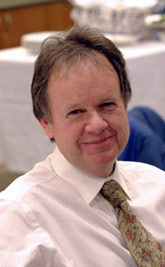
Handy Links
SLAC News Center
SLAC Today
- Subscribe
- Archives: Feb 2006-May 20, 2011
- Archives: May 23, 2011 and later
- Submit Feedback or Story Ideas
- About SLAC Today
SLAC News
Lab News
- Interactions
- Lightsources.org
- ILC NewsLine
- Int'l Science Grid This Week
- Fermilab Today
- Berkeley Lab News
- @brookhaven TODAY
- DOE Pulse
- CERN Courier
- DESY inForm
- US / LHC
SLAC Links
- Emergency
- Safety
- Policy Repository
- Site Entry Form

- Site Maps
- M & O Review
- Computing Status & Calendar
- SLAC Colloquium
- SLACspeak
- SLACspace
- SLAC Logo
- Café Menu
- Flea Market
- Web E-mail
- Marguerite Shuttle
- Discount Commuter Passes
-
Award Reporting Form
- SPIRES
- SciDoc
- Activity Groups
- Library
Stanford
Around the Bay
From the Director of Photon Science: Building for the Future of Photon Science

The Photon Science Directorate at SLAC continues to develop, with new science initiatives aligned with the Department of Energy and SLAC missions, and enabled by a growing and talented scientific workforce. Just in the past year, we have begun new efforts in materials and interfaces, led by Harold Hwang, and in catalysis, led by Jens Nørskov in the new Center for Sustainable Energy through Catalysis, or SUNCAT. Organizationally, these efforts fall within our Materials Sciences and Chemical Sciences Divisions, respectively. We are making plans for future expansion in additional areas, including the biosciences.
SLAC's senior management and scientific leadership have developed a vision and plan for further growing the science we do at SLAC in our Photon Science Directorate. The SLAC Agenda and Annual Lab Plan are aligned with and support these goals. Much of the growth will come in fields that are experimental and will require modern laboratory space. We benefit tremendously from laboratory space on the Stanford University campus, associated with our materials science programs and involving a number of campus-based faculty and students. However, as the Photon Science Directorate grows significantly over the coming decade, we must accommodate an increasing level of experimental science on the SLAC campus if we are to achieve our long-range goals. So what is the plan to do this in the near and longer term?
In the near term, the Photon Science Directorate has been very fortunate to be able to gradually expand its footprint in Building 40, thanks to the willingness of Particle Physics and Astrophysics Directorate-related and other staff to relocate to the Research Office Building and other areas. This has enabled significant renovations to be completed. Others are in progress. Some are already completed. The PULSE Institute, which is part of the Photon Science Chemical Sciences and Materials Sciences Divisions, has moved into completely re-built space in the first and second floors of the two-story wing of Building 40. Enabled by $11M in funding from DOE Office of Basic Energy Sciences, about 18,000 square feet of space, including seven laser laboratories and three chemical/biology laboratories, are now in use. The old "Orange Room" area has been transformed and now houses the Chemical Sciences Division and PULSE/SUNCAT management offices.
To replace the Orange Room, a new, modern 40–50-person conference space is being designed and will be built over the next 12–18 months. With the support of DOE Office of Basic Energy Sciences, contractors are now undertaking an $8M renovation of additional space in Building 40. About 4,000 square feet of space in the second floor of Building 40's two-story wing will be converted into modern laboratories for materials science synthesis and characterization. Much of the office space on the second and third floors of the three-story wing of Building 40 is also being renovated. This will accommodate activities of the Materials Sciences Division (SIMES) and the catalysis center (SUNCAT). It is anticipated that the majority of this last major phase of Building 40 renovation will be completed in 12–18 months. By mid-2012, many of the activities in the Photon Science Directorate will be co-located in the "new" Building 40.
In the longer term, SLAC's ambitious growth plans will require additional laboratory space. To address this and other pressing space needs, SLAC has developed a Signature Building Project. The Project includes a 65,000 square foot Science and User Support Building, or SUSB, and a 55,000 square foot Photon Science Laboratory Building, or PSLB. The SUSB, to be built first, would replace the Panofsky Auditorium and Cafeteria with a modern facility to support our rapidly expanding scientific user community. The PSLB, in proximity to Building 40, would provide expanded laboratory space on the SLAC campus. The SUSB has received Critical Decision 0 approval (approval of mission need) from the DOE and the PSLB mission need is currently under review by the DOE. The project will be done in phases and if funding is available, the SUSB could begin construction in 2013 with the PSLB a few years after that. The SUSB will also house the SLAC Director's Office and related functions. When those activities move from Building 40, an additional 8,000 square feet of space will become available to complete the transformation of Building 40 into the SLAC home for the Photon Science Directorate. With further growth to be accommodated by PSLB, SLAC needs for expanded laboratory and office space for photon science can be met through much of this decade.
